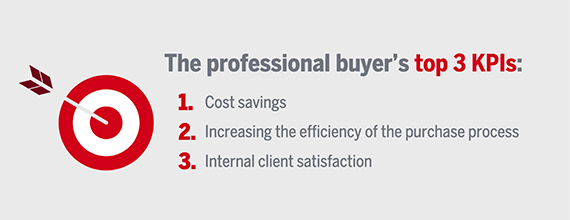
Business buyers may be evaluated internally on how well they perform in three areas: cost savings, purchasing efficiency, and overall satisfaction. Source: Sana Commerce.
Ecommerce can help retain business buyers via expedited reordering, real-time reporting, and improved customer service.
To be certain, business-to-business customer retention is more complicated than B2C, where a good loyalty program and some email automation go a long way.
Rather, B2B retention is often a combination of product quality, consistent delivery, contractual relationships, competitive negotiated prices, and close ties between sales representatives and their buyers.
For example, manufacturers in the health and beauty industry — such as RainShadow Labs and Essential Wholesale and Labs — often own the formulas that small and mid-sized businesses use for their private label soaps, body washes, and shampoos. Thus, customer retention for those manufacturers is tied to the product itself.
Other manufacturers, such as Black & Decker, have representatives calling on retailers. These representatives provide market intelligence and help the buyers at omnichannel chains plan for tool sales. They also offer volume discounts, access to one-time buys, and even take back slow-moving merchandise. Their service goes a long way toward retaining customers.
3 KPIs
Ecommerce, too, can drive B2B customer retention. A good and functional B2B ecommerce site makes buying relatively easier. And when something is easier, it discourages change.
For example, a 2019 survey of more than 500 B2B buyers from Sana Commerce, a B2B platform, identified three key performance indicators:
- Cost savings,
- Purchasing efficiency,
- Client satisfaction.
B2B ecommerce can address at least two of these (efficiency and satisfaction) and, thereby, may encourage professional purchasing agents to stick with a particular supplier.
Purchasing Efficiency
A good B2B ecommerce site can significantly increase purchasing efficiency. Reordering is a good example. But there’s much more. Integration, merchandising, and support all contribute to increased efficiency, which is critical for professional buyers.
Integration. Some B2B ecommerce platforms include robust application programming interfaces. These APIs make it possible for manufacturers and distributors to easily accept and process purchase orders via electronic data interchange, in punch out solutions, or through direct integrations with the customer’s administrative or purchasing software.
A B2B buyer may be reluctant to switch suppliers when there is a timesaving software integration in place.
Merchandising. Next, B2B ecommerce can expose buyers to a manufacturer’s or distributor’s complete catalog.
“Business-to-consumer retailers have spent more than a decade mastering cross-selling, up-selling, personalization, and product recommendations,” wrote Gonzalo Gil, founder and CEO of 3dcart, in a 2017 article.
“The best B2C sellers use big data to sell more to each shopper, and everything they have learned, all of the on-site merchandising techniques, are available to B2B ecommerce sellers. Your company may be able to significantly increase its sales to each customer using techniques and technology already available. This can be a big advantage for your new B2B ecommerce site.”
The B2B on-site merchandising Gil described helps buyers, too, showing them complementary products and special offers. Buyers will likely keep coming back when your site’s merchandising and content contribute to product discovery, product knowledge, and purchasing success.
Support. Finally, a B2B ecommerce site could contain a large and informative knowledge base and otherwise serve as a hub for customer support.
A B2B ecommerce site could offer PDF versions of each product’s safety data sheets. Or it could offer live chat (or even a good bot) for immediate help.
Client Satisfaction
Once every couple of months, a sales representative in the northwest U.S. visits his clients’ home offices. He frequently contacts buyers via email and phone. But in-person meetings give him a chance to provide various reports.
Among these is a report showing everything the buyer ordered, what was delivered, and what is back-ordered. The meeting is highly anticipated and vital because the buyer’s systems won’t necessarily track those products that are ordered and have not arrived. The buyer needs this information to share with his supervisor and discuss it with impacted departments.
But B2B ecommerce can do better. Using the same or similar tools that power B2C accounts, a B2B ecommerce site can offer detailed reporting nearly in real-time. Instead of waiting for a hand-delivered monthly or quarterly report, the buyer can access reports any time via the website.




